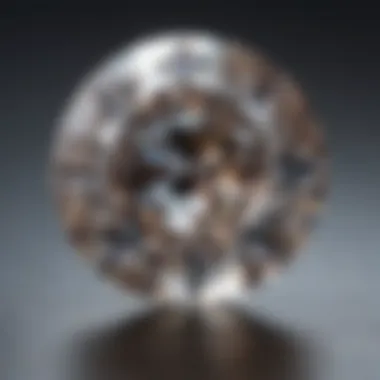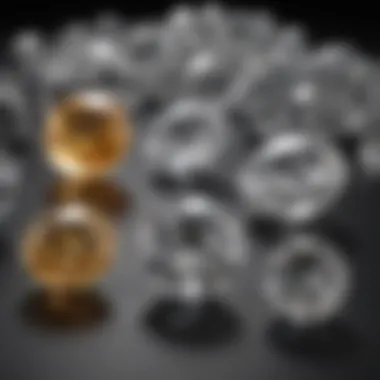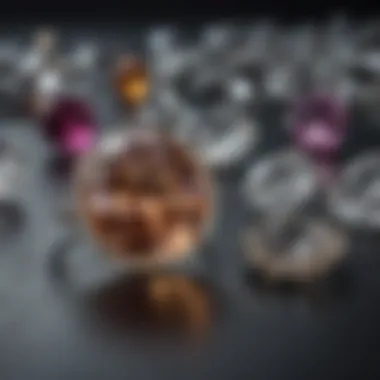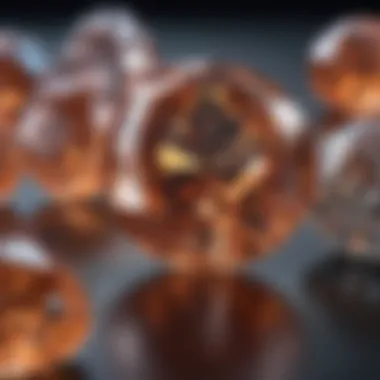Lab Diamonds: Assessing Their Resale Value


Intro
In recent years, lab-grown diamonds have sparked a lively conversation in the world of gemstones. As technology advances and consumer understanding deepens, many jewelers and buyers alike are reassessing the value of these diamonds compared to their natural counterparts. Not just a trade-off in ethical sourcing or environmental impact, the resale value of lab diamonds presents a unique landscape shaped by market perceptions and trends.
People are often surprised to learn that lab-grown diamonds, while visually indistinguishable from natural ones, often carry a different price tag when it comes to resale. Understanding this difference requires a deep dive into the nuances of the gemstone market and factors shaping resale potential.
This exploration aims to unravel the key points guiding the value of lab diamonds. It will highlight how consumer attitudes shape resale expectations, the implications for both buyers and sellers, and how to approach the diamond market whether for investment or personal collection. By the end, readers will garner insights that illuminate the complexities of this evolving segment in the gemstone industry.
Gemstone Overview
Description of the Gemstone
Lab diamonds, created in controlled environments, mimic the natural process of diamond formation over millions of years. They are chemically and structurally identical to natural diamonds. These synthetic gems have gained traction for their affordability and ethical appeal, often marketed as the more compassionate choice in luxury items. This aspect has drawn attention from a demographic seeking sustainability without compromising beauty.
Physical Properties
Lab diamonds boast the same physical properties that define their natural cousins. They exhibit a hardness of 10 on the Mohs scale, making them incredibly durable. Their brilliance and sparkle are a result of how they refract light, which is an identical characteristic to natural diamonds. Thus, when evaluating lab diamonds, one can expect:
- Color: Ranges from colorless to shades of yellow or brown, similar to natural diamonds.
- Clarity: May include inclusions, but typically lab diamonds have fewer blemishes thanks to controlled production.
- Cut: Can be cut to any shape or style, tailored according to personal taste.
Understanding these aspects lays the groundwork for a more thorough analysis of the resale value.
Market Trends and Perceptions
Consumer attitudes toward lab diamonds continue to evolve, heavily influencing their resale value. Several trends emerge when analyzing these diamonds against traditional natural ones.
- Value Proposition: Many buyers perceive lab diamonds as more accessible, offering larger carat sizes for less money compared to natural diamonds.
- Investment Trends: Unlike natural diamonds, lab diamonds typically depreciate once sold, often leading to discussions about long-term value.
"Lab-grown diamonds might be a buyer’s delight, but are they a seller’s dream?"
By assessing current market demands, investors and enthusiasts alike can form better strategies for buying and selling these gemstones.
Implications for Buyers and Sellers
The implications of understanding the resale market for lab diamonds are vast. For buyers, knowing the depreciation rates may affect purchasing decisions; for sellers, grasping market dynamics can optimize selling strategies.
- For Buyers: It’s essential to approach lab diamonds not just as beautiful accessories but as items with a future resale outlook.
- For Sellers: Having realistic expectations about resale values combined with effective marketing can help in navigating the market more successfully.
As we delve deeper into these topics, it becomes clearer that the economic landscape surrounding lab diamonds is constantly shifting. This understanding aids in informed decision-making for every facet of the market.
Understanding Lab Diamonds
Understanding lab diamonds lays the groundwork for comprehending their resale value and distinguishing them from their natural counterparts. This exploration brings to light various nuances associated with lab-grown gems, from their creation to their appeal in modern jewelry. As consumers become more environmentally conscious and budget-aware, lab diamonds are increasingly seen as a viable alternative to mined stones. This section highlights the traits, production methods, and comparisons necessary to engage with the topic of resale effectively.
Definition and Characteristics
Lab diamonds, sometimes referred to as synthetic diamonds or cultured diamonds, are gems created in controlled environments using advanced technology that mimics the natural processes of diamond formation. They possess the same physical, chemical, and optical properties as natural diamonds, making them indistinguishable to the naked eye. Typically, these diamonds are graded on the same scale as their natural counterparts, which includes the renowned 4Cs: Carat, Cut, Color, and Clarity.
One unique characteristic of lab diamonds is their clarity. Since they are synthesized in a lab, the chances of including impurities during creation is significantly reduced. This leads to a higher proportion of lab diamonds receiving top clarity ratings, making them quite desirable for consumers seeking perfection.
Production Process
The production of lab diamonds involves two primary methods: High Pressure High Temperature (HPHT) and Chemical Vapor Deposition (CVD).
- HPHT: This method mimics the natural conditions under which diamonds form in the earth's mantle. Powdered diamond is subjected to extreme heat and pressure, resulting in the formation of synthetic diamonds.
- CVD: In this technique, a diamond seed is placed in a chamber filled with carbon gases. The gases are then heated, leading the carbon to settle on the seed, gradually growing the diamond layer by layer.
Both methods allow for varying characteristics in the final product, including color and size, catering to a wide range of consumer preferences and needs.
Comparison with Natural Diamonds
When it comes to the comparison between lab diamonds and natural diamonds, several factors come into play.


First and foremost is price; lab diamonds typically come with a lower price tag than natural diamonds. On average, consumers can expect to pay around 20-30% less for a lab-grown diamond of similar quality. This price difference can significantly impact consumer choice, especially for those looking to maximize value in their jewelry investments.
Another important consideration is ethical sourcing. Lab diamonds present fewer ethical dilemmas associated with traditional mining practices, which often involve exploitation and environmental degradation. As a result, these creations are gaining a reputation as a more responsible choice within the jewelry market.
Overall, while lab diamonds rival the natural ones in quality and beauty, their unique characteristics, production processes, and market positioning underscore the evolving landscape of the diamond industry. The distinctions laid out here form the essential context needed for understanding how resale values may differ between these two types of diamonds.
Market Dynamics of Lab Diamonds
The landscape of lab diamonds has evolved significantly over recent years, and understanding the market dynamics is crucial for anyone considering buying or selling these exquisite stones. Factors such as consumer sentiment, pricing fluctuations, and technology developments are intertwined, creating a unique market environment. Navigating this dynamic field offers potential benefits and opportunities for both buyers and sellers, but it also comes with its own set of challenges. By grasping these elements, gemstone enthusiasts and investors can make prudent decisions in an ever-changing market.
Current Market Trends
The current market trends for lab diamonds reflect a transformative shift in consumer preference. Rising acceptance of lab-grown diamonds has challenged traditional views on what constitutes value in fine jewelry. Notably, lab diamonds are typically priced lower than their natural counterparts, making them more accessible to a broader audience.
- Increased Popularity: Recent studies indicate that awareness and demand for lab diamonds among younger consumers are on the rise, especially among millennials and Gen Z. They appreciate the ethical considerations and customizable options.
- Changing Retail Formats: Online marketplaces and specialist retailers have surged, allowing consumers to browse and compare prices easily. This has democratized the purchasing process, prompting a reevaluation of traditional retail models.
"With lab diamonds, consumers not only save money, but they often have the chance to be involved in the design process, giving them a personal connection to the piece."
- Sustainability Goals: Increasingly, buyers are looking for sustainable options in their purchases. Lab diamonds, being synthetically created, are marketed as eco-friendly compared to mined diamonds, which brings their own environmental concerns.
Consumer Perceptions
Consumer perceptions of lab diamonds are multifaceted, influenced by a blend of marketing, personal values, and societal trends. Many potential buyers view lab diamonds through the lens of ethics, affordability, and quality.
- Affordability: Many consumers are drawn to the cost-effectiveness of lab diamonds. The ability to purchase a larger stone for the same price as a smaller natural diamond appeals to many, making it an attractive option for engagements or milestones.
- Quality Assurance: Lab diamonds offer clarity and hardness that often surpass their natural counterparts. This assurance builds trust among consumers, reinforcing the belief that they are purchasing a high-quality product.
- Stigma Reduction: As awareness grows, the negative stigma around lab-grown diamonds diminishes. Campaigns emphasizing their ethical advantages are shifting public perception, propelling acceptance.
Industry Growth Projections
The industry growth projections for lab diamonds present a promising avenue for investment and entrepreneurship. Market analysts predict a significant expansion in this sector over the next decade.
- Expected Market Size: According to several reports, the global lab-grown diamond market is anticipated to explode, with estimates nearing $20 billion by 2030. Such growth is likely driven by ongoing technological advancements and shifting consumer priorities.
- Market Entrants: A rise in new companies dedicated to lab-grown diamonds is contributing to competitive pricing and innovation. This influx allows buyers a wider range of choices, pushing established brands to adapt and incorporate lab diamonds into their offerings.
- Global Reach: Markets outside the United States are also embracing lab diamonds. Countries in Europe and Asia show increased interest, broadening the market landscape for producers.
By recognizing these market dynamics, buyers and sellers will find themselves better equipped to navigate the world of lab diamonds. As the market continues to evolve, staying informed will help individuals make knowledgeable choices, contributing to the overall growth and acceptance of lab-grown diamonds in the jewelry industry.
The Concept of Resale Value
The resale value of lab diamonds presents a critical discussion point in today’s gem market. Understanding this concept encompasses much more than merely knowing a stone’s price tag. It invites buyers to consider the implications of their purchase decisions as well as the economic factors intertwined with the gem's longevity in the market. The notion of resale value speaks to the heart of consumer confidence and investment potential, making it an essential theme for collectors, enthusiasts, and jewelers alike.
Defining Resale Value
Resale value can be defined as the expected price that an item — in this case, lab diamonds — will fetch when sold again. This is not a simple calculation; it involves an array of factors including market demand, prestige associated with the gem, and the overall perception of lab diamonds versus their natural counterparts. Upon purchasing a lab diamond, one might wonder, "What if I want to sell this later?" This query highlights the importance of understanding the dynamics of resale value, as it can drastically affect the buyer's initial sentiments about the investment.
Lab diamonds, recognized for their ethical production and affordability, may not retain value like natural diamonds. For instance, while the retail price for natural diamonds may stand comfortably on a pedestal, the resale market for lab diamonds can feel like a slippery slope, which raises eyebrows for potential buyers.
Factors Affecting Resale Value
Several pivotal factors influence the resale value of lab diamonds, making it essential for both buyers and sellers to remain aware of these elements:
- Market Demand and Trends: Just like any other commodity, the supply and demand for lab diamonds play a significant role in their resale value. When interest and purchases increase, prices tend to stabilize. Conversely, if the novelty wears off, the resale price may diminish.
- Quality and Certification: The quality of a lab diamond, much like that of its natural siblings, is paramount. Ratings on clarity, cut, color, and carat weight heavily dictate its resale price. Additionally, certification from reputable agencies can add a layer of assurance to the prospective buyer, bolstering the market value.
- Condition and Upgrades: The physical condition of a lab diamond will naturally affect its sale val. A well-maintained stone will attract higher prices than one that shows signs of wear. Furthermore, the buyers can often be enticed by upgraded settings or accessories that accompany the diamond.
- Consumer Perception: The prevailing sentiments and attitudes toward lab diamonds versus natural ones can provide insight into potential resale prices. Misconceptions about lab diamonds as being less desirable can deter resale, while a shift in public perception may elevate their status and desirability.
"A gem's value lies not just in its brilliance but in the story it carries as it changes hands."
Understanding these factors can empower buyers when they move through the journey of purchasing a lab diamond, ultimately shifting the narrative around lab diamonds from simple decorative pieces to potential (albeit different) investments. The multifaceted nature of resale value invites deeper exploration into how these distinctive stones perform in the market, exposing both challenges and opportunities for enthusiastic investors.
Resale Value of Lab Diamonds Compared to Natural Diamonds
Understanding the resale potential of lab-grown diamonds against their natural counterparts is crucial for anyone wishing to navigate the gemstone market. This comparison sheds light on several important aspects, such as financial implications, consumer perceptions, and the overall market dynamics.
To navigate this topic effectively, it’s vital to consider that the resale value of lab diamonds often rests on lower price points when compared to natural diamonds. This dynamic not only affects the immediate consumer satisfaction but also carries implications for long-term investment potential. Buyers who grapple with decisions on whether to put their money into lab or natural diamonds will find this comparison essential.
It's also important to remember that the emotional weight attached to diamonds can sometimes clash with their monetary value, leading to sentimental considerations that influence purchasing decisions.
Price Comparison
When it comes to the actual price, lab diamonds stand on quite different grounds compared to natural diamonds. Generally speaking, lab diamonds carry a significantly lower price tag—often between 20% to 50% less than natural diamonds with similar characteristics.


This considerable price gap opens up a range of questions:
- Are consumers more likely to opt for lab diamonds purely based on financial rationale?
- Do buyers prioritize visual appearance or are they influenced by price alone?
Natural diamonds have long been associated with a storied history and intrinsic value, which can lead to a greater expectation of resale return. However, lab diamonds have begun to carve out their niche; their price advantages do make them quite appealing to a growing audience of consumers who appreciate value.
Additionally, prices for lab diamonds can be volatile, depending on production trends and technological advances. One could say, an emerging trend or slight reduction in cost can create ripples throughout their resale market—a fact worth monitoring for savvy investors.
"The price a buyer is willing to pay reflects a blend of personal preference, market trends, and inherent value."
Market Demand Fluctuations
Market demand for lab diamonds varies significantly, influenced by dynamic consumer behaviors and broader economic conditions. When economic times are tight, consumers may lean more towards the affordability of lab diamonds.
On the flip side, the attractiveness of natural diamonds during a booming economy cannot be disregarded. Consumers may hunt for the finer things in life, and that often means going for something perceived as classic, like natural diamonds. Here are two notable points about demand:
- Rise and Fall of Demand: There have been spikes in interest and demand for lab diamonds, especially among younger buyers who prioritize sustainability and ethical sourcing.
- Perception Shift: As lab diamonds become more widely accepted, their demand has increased. This shift might affect the resale value as well, where consumers begin to value them not just for price, but for the craftsmanship and ethics behind their production.
Ultimately, understanding the interplay between price and market demand sheds light on the complexities that any potential buyer or seller must consider. Navigating these waters requires keen awareness of not just the numbers but also the attitudes and sentiments that fuel purchasing decisions.
Consumer Behavior in the Resale Market
Understanding consumer behavior in the resale market is crucial for grasping the dynamics of lab diamonds. Lab diamonds, while gaining a solid footing, still present distinct behaviors when it comes to buying and selling. For both buyers and sellers, insights into consumer behavior can illuminate pathways for making informed decisions.
The factors that sway consumer decisions are multifaceted. Price sensitivity, perceived value, and emotional connections play key roles. The decision to sell or buy a lab diamond often begins with an evaluation of how it fits within a person’s financial framework and emotional landscape.
Buying Resale Lab Diamonds
Purchasing lab diamonds on the resale market can be a savvy move. Buyers might find attractive deals compared to retail prices, especially as consumers become more educated about these stones. It’s important for buyers to:
- Evaluate Authenticity: Ensure the lab diamond comes with certification from reputable organizations like the Gemological Institute of America (GIA). Such certifications help to establish trust.
- Understand Market Trends: Buyers should be aware of the fluctuations in market demand. For instance, if demand is on the rise, investing now could yield higher future returns.
- Assess Condition and Setting: Lab diamonds, like their natural counterparts, can wear over time. Analyzing the condition is essential before making a purchase.
Being informed can help buyers not only find value but also satisfy personal desires for ownership.
Selling Lab Diamonds
The act of selling lab diamonds seems simple, but it comes with its own set of challenges and considerations. Sellers might choose to sell for various reasons, including upgrading, changing tastes, or even financial needs. For effectively navigating the sales process, sellers should follow these pointers:
- Know Your Market: Familiarity with current trends can guide sellers in pricing their diamonds correctly. Researching average resale prices proves beneficial.
- Choose the Right Platforms: From specific online marketplaces to local jewelers, understanding where to sell plays a vital role in maximizing returns. Platforms like Reddit and Facebook have specialized groups that can connect sellers directly with buyers.
- Prepare for Negotiation: Sellers should be ready for negotiations. Prices can vary significantly based on the buyer's motivation and the seller’s readiness to let go.
Case Studies of Lab Diamonds in the Resale Market
Understanding the resale market for lab diamonds through real-world examples can provide a clearer picture of their potential value and challenges. Case studies illuminate various lessons about consumer attitudes, market fluctuations, and investment potential. By delving into specific instances where lab diamonds changed hands, buyers and sellers can glean insights into what drives successful transactions and what hurdles remain. This narrative aims to explore these elements, shedding light on the intricacies involved in the resale of lab diamonds.
Successful Resale Transactions
In the realm of lab diamonds, some transactions stand out as particularly successful, showcasing both the desirability of these stones and the effective strategies employed by sellers. For instance, a couple in Chicago purchased a stunning lab-grown diamond engagement ring for about 30% less than a natural equivalent. When it came time for them to upgrade the ring, they resold this stone through an online marketplace dedicated to lab-grown gems. The ring, due to its design popularity and the clarity of the diamond, fetched almost the entire purchase price. This successful transaction highlights a few key factors:
- Quality: The quality of the lab diamond was top-notch—good clarity, brilliant cut—which plays a significant role in resale.
- Trendy Design: The couple opted for a timeless setting, making it appealing to a broader audience.
- Active Marketplace: Utilizing platforms like social media and dedicated jewelry resale websites helped them tap into a niche market eager for lab diamonds.
Overall, this case exemplifies that understanding market trends and maintaining the quality of the gem can lead to positive outcomes when reselling lab diamonds.
Challenges in Resale
Despite the success stories, reselling lab diamonds is not without its challenges. One significant example involved a jewelry maker who crafted bespoke pieces using lab-grown diamonds. Initially, these unique designs sold well at craft fairs and online, but when the designer decided to streamline the collection, the difficulty in moving older styles led to a notable loss. Some challenges in the resale market include:
- Market Saturation: With the rise of lab diamonds, numerous options can clobber potential buyers with choice, making it hard for individual sellers to stand out.
- Perceived Value: Some consumers still favor natural diamonds, viewing them as more prestigious despite lab products being chemically identical. This perception can affect resale prices significantly.
- Limited Recognition: Unlike natural stones, lab diamonds might not hold the same emotional weight for certain buyers, making them less inclined to pay top dollar.
To summarize, understanding both sides of the resale coin is essential. Successful transactions can inspire confidence in new buyers and sellers, while recognizing the challenges faced in these cases can help prepare individuals for potential pitfalls.
"In the world of gemstones, knowledge is power; knowing both the triumphs and the trials can make the difference between a profitable sale and a regrettable one."
Ultimately, both success stories and challenges shape the narrative of lab diamonds in the resale market, providing valuable lessons for gemstone enthusiasts and investors alike.


Implications for Buyers and Sellers
Understanding the resale value of lab diamonds carries significant weight for both buyers and sellers in the gemstone market. The discussions surrounding the palatability of these diamonds are not only about their visual appeal but also about their inherent worth as a potential investment. For buyers, it is crucial to grasp the factors that underpin the resale landscape; aware buyers make informed choices that align both personal tastes and financial goals.
For sellers, a deep comprehension of how lab diamonds fare in resale can illuminate strategies that optimize profit while building trust with potential buyers. Thus, the resale value of lab diamonds has far-reaching implications, influencing personal decisions and shaping market trends.
Investment Considerations
Investing in lab diamonds can be a double-edged sword. On one side, they offer a more affordable alternative to natural diamonds. This characteristic can draw buyers looking for aesthetic beauty without the hefty price tag. However, the depreciation in resale value often intensifies the scrutiny. Essentially, lab diamonds can sometimes lose value when sold, making it imperative for potential investors to assess whether their purchase is merely for adornment or if it plays a more strategic financial role.
- Market Trends: It's useful to look at emerging patterns in the jewel market. Many have seen lab diamonds gaining traction, yet, resale prices have not always kept pace.
- Consumer Demand: Another element to consider is consumer behavior. There’s a growing affinity for lab diamonds, especially among younger generations, which could translate to a healthier resale market in the future.
- Certification and Quality: Persistent attention to quality assurance and certification remains essential. It ensures buyers know precisely what they are investing their money into, paving the way for trust in resale transactions.
Emotional and Sentimental Value
Often undervalued in the gemstone conversation is the emotional and sentimental significance attached to diamonds. For many, a diamond is not simply a piece of jewelry; rather, it embodies memories, milestones, and commitment. This emotional layer shapes both buying and selling decisions.
When someone purchases a lab diamond, they may envision it as an heirloom piece, imbued with personal stories rather than merely as an asset. This sentiment can play a unique role in resale—where emotional value can sometimes outweigh financial logic.
- Connection to Events: For instance, an engagement ring might represent a significant life event, making its resale complicated. The buyer’s connection to it can lower the likelihood of it being put up for sale at all.
- Rarity and Personal Significance: Unlike natural diamonds, lab diamonds can often be produced in specific designs or with unique characteristics that attract the buyer's personal taste. However, that personalization may affect their general resale attractiveness as they might not hold the same allure for someone else.
"Appreciating emotional ties to jewelry is pivotal in understanding the full picture of lab diamond sales and purchases."
Navigating the resale landscape inherently requires understanding the intricate interplay of emotional ties and monetary implications. For buyers, grasping these nuances ensures a judicious approach to their investments while sellers must leverage this understanding to establish rapport and clarity with potential customers.
Future of Lab Diamonds and Resale Value
The exploration of lab diamonds' future and their resale value takes on notable importance as it highlights not just market trends, but the evolution of consumer perception within the gemstone industry. Today, lab-grown diamonds are not seen just as alternatives but as contenders with their own unique value propositions. As technology advances and consumer awareness grows, expectations surrounding these gems will likely pivot in unexpected directions.
The current climate demands that buyers and sellers consider a series of elements crucial to understanding the potential for lab diamonds in the resale market. This section will delve into the dynamics at play, assessing the advantages and implications for various stakeholders.
Emerging Trends
The landscape for lab diamonds is shifting, spurred on by changing social norms and technological innovations. Some key trends include:
- Sustainability and Ethical Consciousness: As environmental awareness grows, many consumers prioritize eco-friendly options. Lab diamonds, being created in controlled environments with less environmental impact, align with these values, thereby increasing their attractiveness.
- Technological Advancements: The techniques used to create diamonds in laboratory settings are constantly evolving. Innovations like chemical vapor deposition and high-pressure, high-temperature synthesis are refining the quality of lab diamonds. This drives competitiveness with natural stones, enhancing their market viability.
- Direct-to-Consumer Sales Models: Online sales platforms allow consumers to explore, purchase, and even resell diamonds with greater ease. Brands like Brilliant Earth and MiaDonna are at the forefront, employing transparent marketing strategies and making lab-grown diamonds more accessible to the average consumer.
These trends suggest a growing acceptance and legitimacy of lab diamonds, which can influence their resale value positively as the market transforms.
Predictions for Market Evolution
Looking ahead, the resale value of lab diamonds could change dramatically. Various predictions can be made based on ongoing trends, including:
- Increased Market Convergence: Lab-grown and natural diamonds may see their prices converge as the distinction in consumer minds blurs. This can lead to a reevaluation of resale value for both categories of diamonds.
- Fluctuation in Demand: As lab-grown diamond awareness rises, demand may experience fluctuations tied to economic conditions. A downturn could lead to more buyers opting for lab stones over natural ones due to cost-effectiveness. Conversely, a booming economy might translate to increased demand for high-value pieces, irrespective of origin.
- Legislation and Certification: As regulations around gem quality and sourcing tighten, lab diamonds may come under increased scrutiny. The presence of strict certification processes could bolster buyer confidence, thereby enhancing resale values.
In summary, the future for lab diamonds appears promising, particularly within resale markets. As time unfolds, keeping a keen eye on emerging trends and consumer sentiment will be crucial for understanding their evolving value.
"Understanding the progress of lab diamonds isn't just about observing prices; it's about discerning a paradigm shift in consumer values and expectations."
This discourse on the future of lab diamonds and their resale potential serves not only to provide clarity but urges stakeholders to prepare for continuous shifts in this vibrant segment of the market.
Finale
The conclusion section brings everything full circle, tying together the critical components of lab diamonds and their resale value. This topic not only sparks interest among gemstone enthusiasts, collectors, and even casual buyers, but it also probes into the economic aspects of the diamond industry as a whole. Understanding the resale potential of lab diamonds is fundamental for various stakeholders, from investors to individuals considering a personal purchase.
Summary of Key Points
In reviewing the discussion throughout this article, we can pinpoint several significant observations:
- Market Growth: Lab diamonds are gaining traction in the market, increasingly viewed as legitimate alternatives to natural diamonds.
- Resale Value Factors: Several elements, such as quality, market trends, and demand dynamics, play pivotal roles in determining the resale values of both lab and natural diamonds.
- Consumer Behavior: Perceptions surrounding lab diamonds vary, influencing how buyers approach resale transactions.
- Investment Considerations: Buyers and sellers need to factor in emotional ties alongside economic perspectives when dealing with lab diamonds.
Understanding these aspects can significantly enhance decision-making processes for those exploring investments in diamonds.
Final Thoughts
As we gaze into the future of lab diamonds, one can’t help but note their increasing acceptance and growing market presence. This rise encourages a shift in consumer attitudes and behaviors, which in turn shapes the resale market landscape.
For buyers, it’s crucial to comprehend that while resale value may not always match that of natural diamonds, lab diamonds can still hold significant worth, especially as societal norms continue to evolve.
The path forward is bright, and as more individuals engage with lab diamonds, the narrative surrounding their resale value will likely become increasingly complex and compelling.







